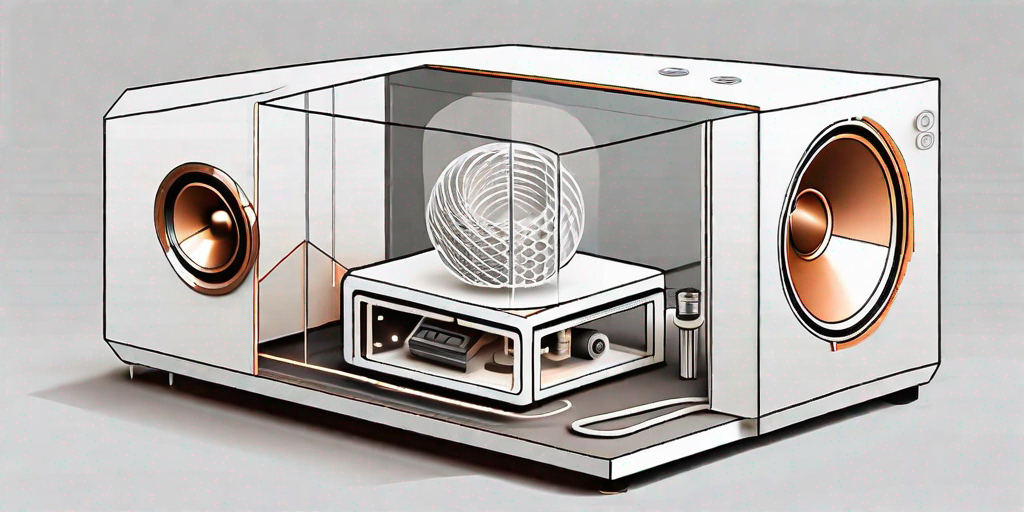Understanding 3D Printing: The Role of an Innovation Speaker

Understanding 3D Printing: The Role of an Innovation Speaker
In recent years, 3D printing has become a revolutionary technology that has the potential to transform industries, from healthcare to manufacturing. However, the intricacies of this technology can sometimes be difficult to grasp. This is where the role of an innovation speaker becomes crucial. These experts have the unique ability to simplify complex concepts and bridge the gap between technical jargon and real-world applications, making 3D printing more accessible to the general public.
Understanding the Basics of 3D Printing
Before we delve into the role of an innovation speaker, it is important to first understand the basics of 3D printing. At its core, 3D printing, also known as additive manufacturing, is a process of creating three-dimensional objects by layering materials, such as plastic or metal, based on a digital model. Unlike traditional manufacturing methods that involve subtracting material, 3D printing builds objects layer by layer, allowing for greater design flexibility and customization.
Imagine a world where you can turn your wildest imagination into reality with just a few clicks. That's the power of 3D printing. It has opened up a whole new realm of possibilities, enabling individuals and businesses to bring their ideas to life in ways that were once unimaginable.
One of the key advantages of 3D printing is its ability to create complex geometries that would be impossible or extremely difficult to achieve with traditional manufacturing methods. This means that designers and engineers can push the boundaries of what is possible, creating intricate and innovative designs that were previously only seen in science fiction.
Whether it's creating prototypes, functional parts, or even entire buildings, 3D printing has the potential to revolutionize the way we manufacture and produce objects. The ability to quickly iterate and test designs allows for faster product development cycles, reducing time to market and increasing overall efficiency.
But 3D printing is not just limited to manufacturing. It has also found applications in various fields such as healthcare, aerospace, automotive, and even fashion. In the medical field, 3D printing has been used to create customized prosthetics, implants, and surgical models, improving patient outcomes and reducing costs.
In the aerospace industry, 3D printing has enabled the production of lightweight and complex components, leading to fuel efficiency and performance improvements in aircraft. The automotive industry has also embraced 3D printing, using it to create prototypes, tooling, and even end-use parts.
However, the technology is constantly evolving, and staying up-to-date with the latest advancements can be a challenge for many individuals and businesses. From new materials and printing techniques to improved software and hardware, the world of 3D printing is a dynamic and rapidly changing one.
That's where an innovation speaker comes in. An innovation speaker is someone who is not only knowledgeable about the latest trends and developments in 3D printing but also has the ability to inspire and educate others about the potential of this technology. They can provide insights into how 3D printing is transforming industries and offer practical advice on how to leverage its capabilities for business growth and success.
So, whether you are a designer looking to explore new creative possibilities, an engineer seeking to optimize manufacturing processes, or a business owner wanting to stay ahead of the competition, understanding the basics of 3D printing is just the first step. Embracing this technology and harnessing its potential requires continuous learning and a mindset of innovation.
The Role of an Innovation Speaker in Mastering 3D Printing Technologies
This is where an innovation speaker comes in. With their extensive knowledge and experience in the field of 3D printing, these experts are able to simplify complex technological concepts and explain them in a way that is both understandable and engaging. They have the unique ability to break down intricate processes into bite-sized pieces, making it easier for individuals to grasp the underlying principles of 3D printing.
Moreover, an innovation speaker can provide valuable insights into the latest developments and trends in the world of 3D printing. They have access to a vast network of industry professionals and researchers, allowing them to stay at the forefront of this rapidly evolving field. By sharing their expertise and experiences, they can inspire and educate audiences, helping them navigate the complex landscape of 3D printing.
One of the key areas where an innovation speaker can make a significant impact is in the realm of materials used in 3D printing. While most people are familiar with the idea of printing objects using plastic, there is a wide range of other materials that can be utilized. These include metals, ceramics, and even biological materials such as living cells. An innovation speaker can delve into the various properties and applications of these materials, highlighting the potential for groundbreaking advancements in fields like medicine, aerospace, and manufacturing.
Another aspect that an innovation speaker can shed light on is the role of 3D printing in sustainability and environmental conservation. Traditional manufacturing processes often result in a significant amount of waste material, but 3D printing has the potential to minimize this waste by only using the necessary amount of material for each object. Additionally, the ability to create complex geometries and lightweight structures through 3D printing can lead to more energy-efficient designs. By discussing these aspects, an innovation speaker can inspire individuals and organizations to adopt more sustainable practices in their manufacturing processes.
Furthermore, an innovation speaker can explore the intersection of 3D printing with other emerging technologies. For example, the combination of 3D printing with artificial intelligence and robotics has the potential to revolutionize industries such as construction and healthcare. By integrating these technologies, it becomes possible to automate certain aspects of the 3D printing process, increase precision, and create objects with enhanced functionality. An innovation speaker can delve into these exciting possibilities, sparking discussions and collaborations among professionals from different fields.
Lastly, an innovation speaker can address the challenges and ethical considerations associated with 3D printing. As this technology becomes more accessible, questions arise regarding intellectual property rights, safety regulations, and the potential for misuse. By engaging in thoughtful conversations and providing guidance, an innovation speaker can help individuals and organizations navigate these complex issues and ensure responsible and ethical use of 3D printing technologies.
Unveiling the Potential of 3D Printing
One of the key roles of an innovation speaker is to unveil the vast potential of 3D printing. From healthcare to aerospace, this technology has the power to revolutionize numerous industries.
Let's dive deeper into the healthcare sector. With the advent of 3D printing, medical professionals have been able to create patient-specific implants and prosthetics. This means that individuals who have lost a limb or have a congenital condition can now have customized solutions that perfectly fit their unique anatomy. Not only does this improve the quality of life for countless individuals, but it also reduces the risk of complications and discomfort that can arise from using generic, one-size-fits-all devices.
But the impact of 3D printing doesn't stop there. In the field of medicine, researchers are exploring the possibility of printing human organs. Imagine a future where waiting lists for organ transplants are a thing of the past. With 3D printing, organs can be created using a patient's own cells, eliminating the need for donors and the risk of rejection. This breakthrough has the potential to save countless lives and revolutionize the field of organ transplantation.
Now, let's shift our focus to the manufacturing sector. 3D printing has the potential to streamline production processes and reduce waste. Traditional manufacturing methods often involve creating molds or tooling, which can be time-consuming and expensive. With 3D printing, objects can be created layer by layer, eliminating the need for molds and reducing production time. This not only saves costs but also allows for greater flexibility in design iterations.
Furthermore, 3D printing enables on-demand manufacturing and customization. In the past, companies had to produce large quantities of a product to make it cost-effective. This often led to excess inventory and wastage. With 3D printing, products can be manufactured as needed, reducing the need for stockpiling and minimizing waste. Additionally, customization becomes easier and more affordable, as each product can be tailored to meet the specific needs and preferences of the customer.
Imagine a world where you can order a pair of shoes and have them 3D printed to perfectly fit your feet, or where you can design and print your own personalized smartphone case. The possibilities are endless, and the potential for innovation is immense.
By attending a talk by an innovation speaker, audiences can gain a deeper understanding of the immense possibilities that 3D printing holds. Through expert insights and real-world examples, they can explore the potential applications of this technology in various industries and envision a future where 3D printing is an integral part of our lives.
How an Innovation Speaker can Simplify Complex 3D Printing Concepts
Let's face it, not everyone has a technical background or the time to delve deep into the intricacies of 3D printing. This is where an innovation speaker's talent truly shines. They have the ability to take complex concepts and break them down into simple, relatable terms that anyone can understand.
By using relatable analogies and everyday examples, an innovation speaker can make 3D printing concepts accessible to a wider audience. They understand that not everyone is an engineer or a designer, and they tailor their presentations to cater to audiences with varying levels of technical knowledge. Through their ability to simplify complex concepts, they empower individuals and businesses to embrace the potential of 3D printing.
Exploring Real-world Applications of 3D Printing
One of the most effective ways for an innovation speaker to engage their audience is by showcasing real-world applications of 3D printing. By highlighting success stories and innovative use cases, they enable audiences to see firsthand how this technology is transforming industries.
From the creation of art installations to the production of spare parts in remote locations, 3D printing has already sparked a wave of creative and practical applications. An innovation speaker can bring these examples to life by sharing stories and providing detailed insights into how 3D printing is solving real-world challenges.
Conclusion
In conclusion, 3D printing is a technology that holds immense promise for the future. However, its complexity can often be a barrier for many individuals and businesses. This is where an innovation speaker plays a crucial role. With their ability to simplify complex concepts, unveil the potential of 3D printing, and explore real-world applications, they empower audiences to embrace this transformative technology. So the next time you find yourself struggling to grasp the intricacies of 3D printing, consider seeking the guidance of an innovation speaker who can bring clarity and understanding to this rapidly evolving field.
FAQ
1. What is 3D printing?
Answer: 3D printing, also known as additive manufacturing, is a process of creating three-dimensional objects by layering materials based on a digital model. Unlike traditional manufacturing methods, 3D printing builds objects layer by layer, allowing for greater design flexibility and customization.
2. How is 3D printing revolutionizing industries?
Answer: 3D printing has the potential to revolutionize industries by enabling faster product development cycles, reducing time to market, and increasing overall efficiency. It can create complex geometries that would be impossible with traditional manufacturing methods, leading to innovative designs. Additionally, 3D printing has found applications in healthcare, aerospace, automotive, and other fields, improving outcomes and reducing costs.
3. What role does an innovation speaker play in mastering 3D printing technologies?
Answer: An innovation speaker simplifies complex technological concepts and explains them in an understandable and engaging way. They provide insights into the latest developments and trends in 3D printing, explore the potential of different materials, discuss the intersection of 3D printing with other emerging technologies, and address challenges and ethical considerations. Their expertise and experiences inspire and educate audiences, helping them navigate the complex landscape of 3D printing.
Contact an Innovation Speaker for Your Event
If you're looking to make your next event truly inspiring and informative, Dr. Mark van Rijmenam is the innovation speaker you need. With his extensive knowledge and experience in 3D printing, he can simplify complex concepts and unveil the transformative potential of this technology. He will not only engage your audience with real-world applications of 3D printing but also spark innovative thinking and discussions. Don't miss the opportunity to have Dr. van Rijmenam enlighten your audience about the future of 3D printing and its impact on various industries. Simply complete the form below and we'll be in touch within 24 hours to discuss how Dr. van Rijmenam can make your event a memorable one.
Thanks for your inquiry
We have sent you a copy of your request and we will be in touch within 24 hours on business days.
If you do not receive an email from us by then, please check your spam mailbox and whitelist email addresses from @thedigitalspeaker.com.
In the meantime, feel free to learn more about The Digital Speaker here.
Or read The Digital Speaker's latest articles here.





